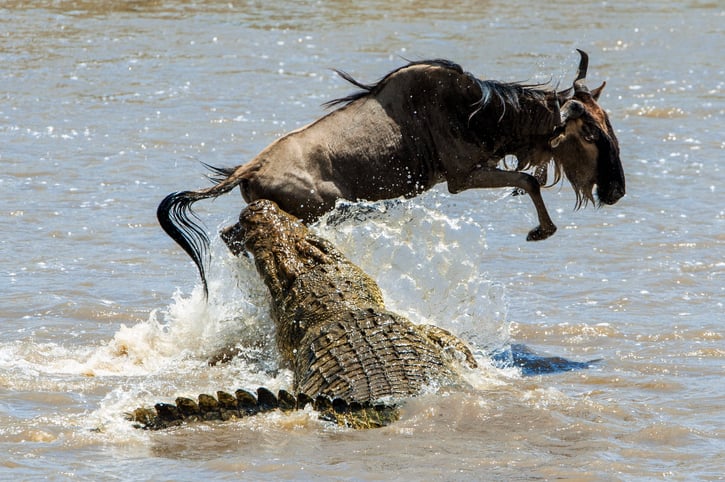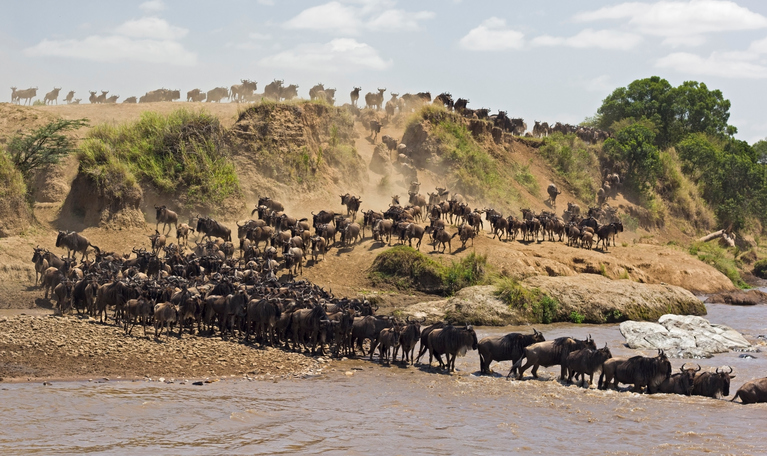Windows 10 Migration: A Tale of Two Herds
The Great Wildebeest Migration in the Serengeti is the largest single movement of animals anywhere in the world. It occurs annually and continues indefinitely.
Millions of wildebeest, along with hundreds of thousands of zebras and gazelles, leave their calving grounds in the Southern Serengeti and head for new water sources in the Kenyan Masai Mara, traversing different countries and terrains, to reach their goal.
So, what do these stunning beasts have to do with Windows 10?
Well, with Microsoft Windows 10 operating system updates now being pushed out more regularly, this enforced release cadence is imposing continuous migrations on organizations and forcing mass movements of users.
Like the wildebeest, millions of Windows 7 users, in fact 49.5 percent of overall desktop operating system users, according to netmarketshare.com, need to undertake a long and arduous journey to the Windows 10 promised land.
Additionally, a huge number of Windows XP (10.5 percent) and Windows 8. x (12.1 percent) users, comparable to the zebras and gazelles of the Serengeti, need to tag along too.
Let’s take a deeper look at the annual Great Serengeti Wildebeest Migration and contrast how two different metaphorical “organizational herds” typically address Windows migration projects.
Migration Phase 1
Typically, wildebeest herds prepare to leave their calving grounds and start the long journey south. With a lot of inexperienced calves tagging along, the beginning of the journey is difficult and dangerous. Predators lie in wait.
- Organizational Herd A
Supporting IT users of differing abilities is always difficult. From Baby Boomers (50+ years old), through Generation X (36-50 years old) to Millennials (18 to 35 years old), users require different levels of support when working with Windows Desktops.
Inexperienced users are more susceptible to social engineering and fall prey to ransomware and other malicious attacks more easily. They need more protection.
In addition, an inexperienced IT department can be unprepared for a Windows migration and thus pitfalls await.
Without upfront analysis of the existing IT environment, it will be a difficult journey to identify how to optimize and secure the Windows 10 estate, which will ultimately lead to a poor user experience and reduced user acceptance.
- Organizational Herd B
With proper preparation and the concept of user experience at the forefront of planning, common migration pitfalls can be avoided.
By analyzing the current endpoint environment and identifying application requirements such as license usage, required privileges and attempted installs, the new operating system environment can be secured and streamlined to satisfy user needs.
In addition, benchmarking user experience metrics such as logon times, CPU usage or memory consumption will ensure the user acceptance and hence success of the Windows migration project will be heightened.
Migration Phase 2
During this period the wildebeest typically graze and wait for the next step of their gruelling journey.
- Organizational Herd A
A long period of reflection on how and when the migration will continue. What unexpected issues were uncovered during Proof of Concept phase? Were unforeseen stability and reliability issues experienced? What about performance? Security? What can be done to avoid future dangers?
- Organizational Herd B
Migration Phase 2 is short for this organizational herd as the up-front analysis identified a large majority of potential pitfalls associated with security, performance and application requirements.
Migration Phase 3
There is no food left for the Wildebeest in their current location. The herd begins to gather in readiness for a move.
- Organizational Herd A
On business devices, end-users are stuck on older operating systems, while their personal devices are up-to-date and making use of the latest applications and resources. There is an urgency and desire from employees to force a move to Windows 10.
This urgency leads to mistakes, which can set the migration back and lengthen Migration Phase 3 dramatically.
- Organizational Herd B
End users have heard about the quick success of the proof of concept phase. Word spreads quickly and, using centralized deployment techniques with templated installation, IT is ready for an influx of devices to be migrated. Migration Phase 3 doesn’t last long for this organizational herd.
Migration Phase 4
The wildebeest re-start their journey across the Serengeti, the migration begins in earnest.
- Organizational Herd A
Steady at first, a sub-set of user’s desktops are now being migrated to Windows 10 as part of a pilot implementation. After rollout, performance, productivity and security issues become apparent. Troubleshooting is difficult. Some endpoints are rolled back.
- Organizational Herd B
Through proper planning and the use of the correct solutions to aid with the rapid deployment of OS images, applications, data and personal settings, Migration Phase 4 is a huge success and is accomplished quickly.
Migration Phase 5
The Wildebeest funnel together and mass herds are now en route to their next destination.
- Organizational Herd A
The pilot was eventually completed, but wasn’t without issue. Unforeseen problems such as slow logon times, poor desktop and application response times or missing applications hampered initial progress. As market awareness of Windows 10 grows, other business units are now becoming interested to have their desktops migrated to Windows 10, putting further pressure on the IT department.
- Organizational Herd B
The quick success of the pilot phase had become legendary amongst the end users. Everyone wants to reap the benefits of a fast, secure and modern desktop operating system.
Migration Phase 6
The herds are now mid-migration and pre-pare for the toughest part of their journey.
- Organizational Herd A
IT are busy utilising disparate toolsets and scripts to attempt to manage and monitor the migration of many thousands of users. Some users fall by the wayside as issues hamper deployment. Others lose interest due to delays and slow troubleshooting of issues.
- Organizational Herd B
Hundreds if not thousands of desktops have now been successfully migrated to Windows 10. User feedback is very positive.
Migration Phase 7
The wildebeest must now undertake a perilous river crossing. Not everyone will make it. Nile crocodiles take the weak and vulnerable.
- Organizational Herd A
Business units are mid-migration. Reports of poor logon times, bad user experience or lack of user privileges result in some users opting out of the migration process.
Insecure and unpatched desktops can lead to malicious attacks that take down devices. Ransomware outbreaks successfully deliver their payload and put the migration project back days, if not weeks, while data is attempted to be restored or ransoms are arranged to be paid, ultimately affecting future IT budgets.
- Organizational Herd B
There are no victims of ransomware as the new environment has all the latest security patches deployed, all users have had admin rights removed and application control techniques are enforced to stop malicious code from being introduced.
The IT estate is a safe haven for end users.
Migration Phase 8
The survivors that successfully crossed the river pause and celebrate by feasting.
- Organizational Herd A
The migration has been a long and difficult process. Large numbers of users have been migrated, but many users are unhappy due to the false promises of a faster desktop and implemented security techniques have locked the system down to within an inch of its life, massively affecting user productivity.
- Organizational Herd B
From day one, the migration project has been seamless to the end user. Optimum user experience and a more secure desktop is achieved through upfront planning and proper implementation. User acceptance is high and the migration is viewed as successful by both end users and senior executives.
Migration Phase 9
The herds now break up into smaller groups.
- Organizational Herd A
Various business units within the organization are now using Windows 10. However, certain users no longer have access to specific required applications or tools. Personal settings have been lost. User files are missing. Productivity is again affected and user perception of the IT department is diminished.
- Organizational Herd B
IT have delivered context-aware Windows 10 desktops to differing business units or user personas. Each user workspace is personalized to their own needs and personal settings and data is exactly where the user expects it to be.
Migration Phase 10
Each of the smaller groups stabilize and become self-sufficient
- Organizational Herd A
IT believe their job is done – they have delivered a Windows 10 endpoint to the business and its employees. The management of the desktop is handed down to individual business units.
Lack of training or handover quickly results in increased support calls and inter-departmental blame. Due to the complexity of the new solution, no trust is placed on the users to help themselves.
- Organizational Herd B
Windows 10 migration has been a complete success. Self-service tools included with the selected migration solutions allow users to help themselves and resolve any common issues without IT intervention and with very little training. Self-sufficiency is achieved rapidly.
Migration Phase 11
The rains begin, forcing the wildebeest to leave the grasslands and head back to the Serengeti.
- Organizational Herd A
After migrating to Windows 10, user experience is extremely poor, if not worse than the legacy desktop estate. This can lead uses to resort to shadow IT or to roll back to older platforms.
This introduces new security vulnerabilities, application compatibility issues and increased support costs, just adding to the IT department’s existing pain.
- Organizational Herd B
An increased Windows 10 release cadence drives both users and IT towards continuous migration patterns. Having planned correctly and utilized the correct migration solutions upfront, this organizational herd is future proof and ready for further migrations.
Migration Phase 12
The wildebeest return to fresh grazing on the Serengeti plains. Calving begins again. Predators, including lions, hyenas and cheetahs return.
- Organizational Herd A
With users stuck with an unstable, insecure and complex workspace, Microsoft releases additional updates to the OS. This increases instability of the desktops and introduces further fear, uncertainty and doubt in the environment.
On top of this, new end-users join the herd and need on-boarding. Some are not tech savvy and susceptible to social engineering and other forms of malicious attack.
The whole sorry migration process needs to begin again.
- Organizational Herd B
The latest Windows updates arrive. No problem.
Operating system and application patches are rolled out quickly and successfully to endpoints without any user disruption. If anything, this was far easier than last time!
User experience is still massively high. Security is strong, yet unobtrusive, so it doesn’t interfere with user productivity.
Get there fast and avoid the predators!
What can we learn from the different journeys these metaphorical organizational herds took to mass migration?
Organizational Herd A lacked insight into their existing environment, failed to plan and used incorrect solutions to assist with their migration. This led to a bad and costly experience for both users and the business as a whole.
Organizational Herd B had a safer, much faster route to migration success. Through forethought, preparation and by utilizing the most suitable migration aids, mass movement of users to a new desktop was quick, secure and cost effective.
So, unlike the annual migration of the wildebeest, any update to your existing operating system doesn’t need to be daunting.
Ivanti’s solutions are designed to reduce the time and complexity associated with Windows migration projects and to secure users from malicious attacks.
By separating all the user-specific aspects from the underlying OS and applications, Ivanti removes the manual IT effort required for new platform implementations, dramatically speeding up the migration process and making you future proof for any further OS updates.
In addition, stopping unknown apps from running and preventing unnecessary access to IT resources through privilege management vastly decreases the predatory threats from ransomware and other malicious attacks.
Users will always seek fresh grazing on the latest OS releases. With Ivanti, you can ensure a fast and safe migration while protecting the weak and vulnerable from lurking predators.
Discover more by clicking here.


